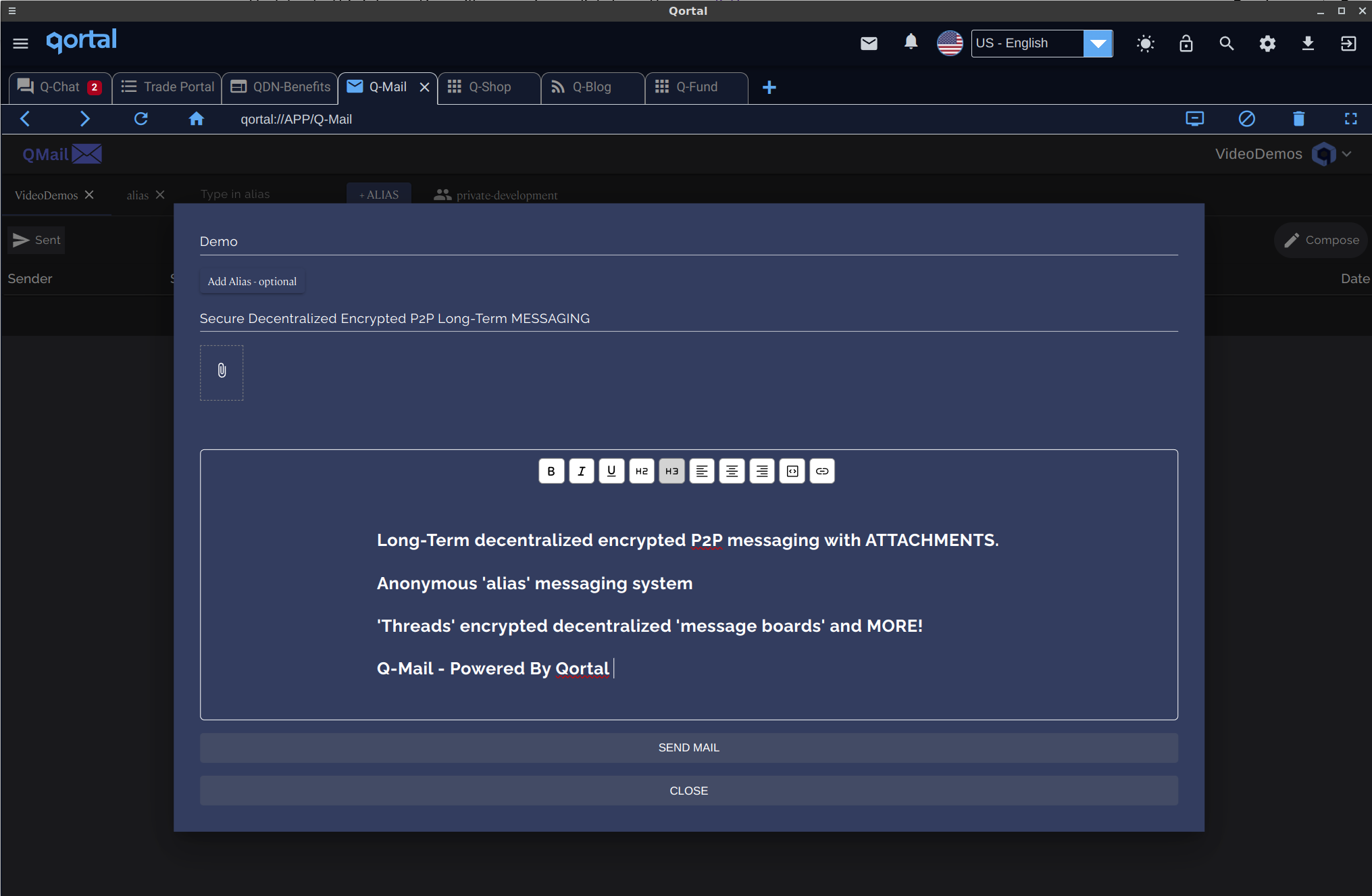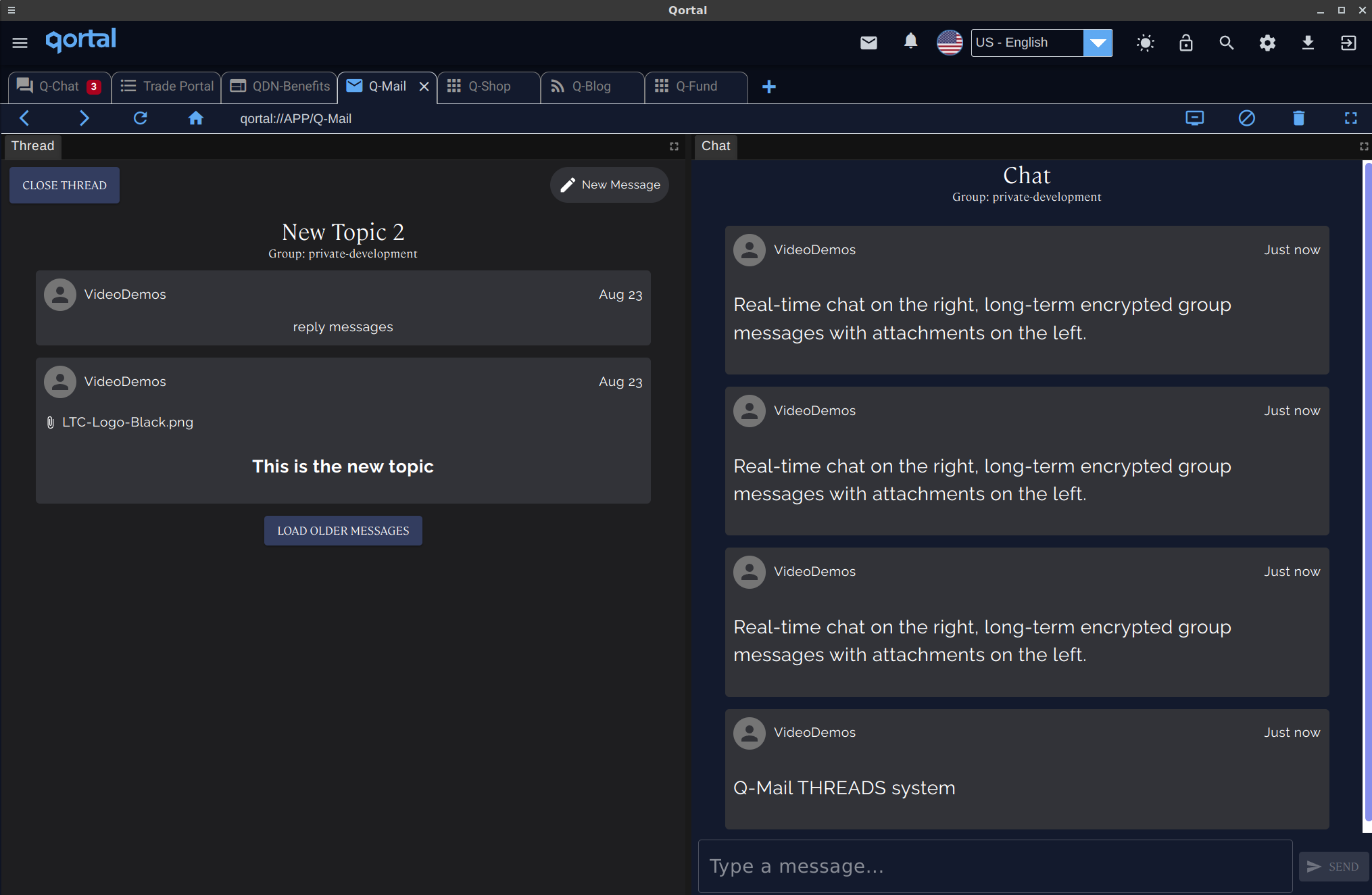Table of Contents
Q-Mail
Q-Mail is the newest messaging application built on QDN.
Any application published on QDN, and not part of the Qortal UI, is referred to as a Q-App. Q-Apps can be published by ANY USER without any sort of 'approval' needed.
Q-Mail is a long-term messaging platform capable of text-based messages of whatever length, that are both ENCRYPTED and DECENTRALIZED. Leveraging the power of QDN (Qortal's Data Network), Q-Mail allows an e-mail replacement system to send 'e-mail like' messages to any registered name on Qortal.
Q-Mail was also the first 100% encrypted messaging platform on Qortal. Both GROUPS AND PRIVATE MESSAGES are encrypted, chunked, and distributed from node-to-node in the same fashion as any other data published on QDN, but the data is NOT ABLE TO BE DECRYPTED UNLESS THE MESSAGE INCLUDED THE NAME IN THE 'TO' FIELD, OR THE USER WAS PART OF A PRIVATE GROUP THAT WITHIN PUBLISHED A 'THREAD'.
Q-Mail Features
Q-Mail messaging - Messaging on Q-Mail allows P2P messages with up to 25MB attachments and 'unlimited' text length, to be sent from one registered name to another. The ONLY TWO people who can READ messages on Q-Mail, are the SENDER AND RECEIVER. That is that. NO OTHER ACCOUNT CAN EVEN ATTEMPT TO READ MESSAGES ON Q-MAIL.
Threads
Q-Mail 'threads' - Q-Mail 'threads' are applied to private groups only as of November 2023, and allow for message-board-like messaging between group members - these message-board-like messages last 'forever' as long as at least one node from within the group members has read it, or follows the name that published it. Q-Mail threads will in the future also apply to public groups, but at the moment to test the functionality in a more limited fashion, are applied to PRIVATE GROUPS.
Alias (anonymous messaging)
Q-Mail 'alias' (anonymous messaging system) - Q-Mail also has within its functionality, 'alias', which allows the users of Q-Mail to send messages to a 'fake name' that is decided upon elsewhere, and shared between the users prior to the message being sent. This system is to allow ANONYMOUS MESSAGING ON Q-MAIL. To use 'alias', users will decide the alias to be utilized, then send a message with an alias they created.
For example:
Bob wants to message Alice, and neither of them want anyone else to be able to pull data from the Qortal API to determine they have messaged one another.
Bob messages Alice in text, a single word 'joy'. Alice and Bob have an understanding that when a single word is sent in such a fashion, it is meant to be an alias on Q-Mail.
Bob then drafts a Q-Mail message to Alice registered name, and applies the alias 'joy' to the message. This ensures that the message is not only accessible solely by Alice, but also cannot be 'traced' from Bob's account to Alice's account by way of pulling data from the Qortal API. Bob sends the message to Alice with the 'joy' alias.
Alice then opens Q-Mail, and clicks 'Alias' and adds 'joy' as an 'alias inbox' which is then created. Once she does this, she sees a message from Bob in the 'joy' inbox, and reads it.
Now, there are choices involved here as well…
If Alice decides to send the message back with the SAME alias, that may very well defeat at least a portion of the purpose overall, as users could then see two messages to 'joy' and assume it was an alias. So… Alice decides to text Bob back 'bountiful' which she then utilizes for her 'return alias'.
Alice drafts the reply message to Bob, and uses the 'bountiful' alias.
Bob then inputs 'bountiful' alias, creates the 'bountiful alias inbox', and reads Alice's message.
Now… since anyone can input the name of an alias, and open an inbox, they may be able to see that a user has sent a message previously utilizing the same alias, however, since the messages are also encrypted to the user in the 'to' field, they cannot open the messages unless they were sent TO THEM.
This creates a completely secure, and anonymous messaging system, with Q-Mail 'alias'.


